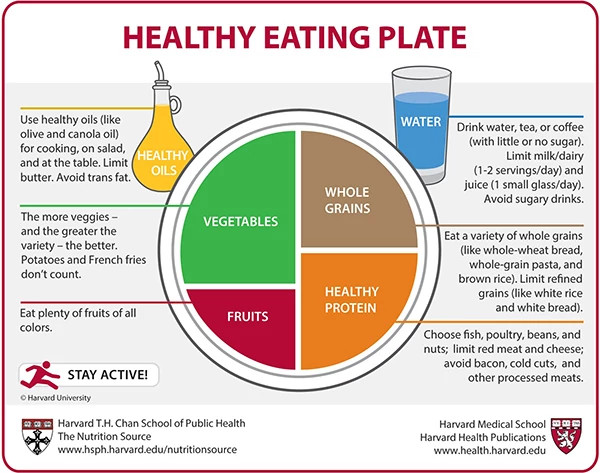This Harvard Healthy Eating Plate is a simple visual that reflects a large body of scientific research on what healthful, plant-based eating looks like. These recommendations are very consistent with what is currently known about how to eat for cancer prevention and survivorship. The overall goal should be to strike a healthy balance of foods at each meal by planning your plate into these sections:
- 1/2 vegetables and/or whole fruits
- 1/4 protein
- 1/4 whole grains (or starchy vegetable)
- A moderate amount of healthy fats distributed through the meal
- Plenty of water
Below are tips on how to plan for each part of your plate for optimal nutrition.

Fruits and Vegetables
Fruits and vegetables contain phytonutrients, natural disease-fighting compounds that support your immune system’s ability to defend you against disease. These compounds offer protection by neutralizing cell-damaging oxidation and inflammation; boosting your immune response; inhibiting potentially cancerous cells from gaining their own blood supply (angiogenesis); encouraging apoptosis (cancer cell death); and assisting your body with natural detoxification.
As the types of phytonutrients in a plant are often tied to the pigments that give them color, if you vary the colors of your fruits and vegetables you will naturally vary your phytonutrient intake. Aim for 5-10 servings of fruits and vegetables per day.
One serving is equal to:
- 1 cup of leafy greens, berries, or melon chunks;
- 1/2 cup for all other cut, cooked, or sliced fruit or vegetable;
- 1 medium-sized fruit or vegetable (e.g., apple or orange);
- 1/4 cup dried fruit;
- 3/4 cup or 6 ounces of 100% juice or fresh juice.
Whole Grains
Whole grains retain all their nutrient-rich elements, including the bran, germ and endosperm, and are important sources of fiber, phytonutrients, vitamins and minerals. Whole grains are also an excellent source of dietary carbohydrates, which are the primary source of energy for the body.
Whole grains include rolled or steel cut oats, brown rice, quinoa, buckwheat, bulgur, buckwheat, popcorn, millet, barley and sorghum, and breads products, cereals and crackers that list a “100% whole” grain as the first ingredient. This ¼ of the plate can also include starchy vegetables, like sweet potatoes, winter squash, peas and legumes, which are also nutrient-rich sources of carbohydrate.
Protein
Protein is necessary for the growth and repair of all the cells in your body, including red blood cells, white blood cells, immune factors, and muscles, all of which need reinforcement during and after cancer treatment. When selecting a protein, choose lean, high-quality sources, such as seafood, poultry, lean red meats (loin, round or flank cuts), low-fat dairy (milk, yogurt or cheese), eggs, soy foods (tofu, edamame, tempeh), nuts/nut butters, seeds, quinoa and legumes.
Fats
A diet high in omega-3, mono- and polyunsaturated fats from plant oils, nuts, seeds, and fish is recommended for a number of health reasons, and is an important part of an “anti-inflammatory” diet. Healthy sources of fats include fatty fish (salmon, lake trout, tuna, herring, sardines); olive, canola, peanut and flax oil; nuts and seeds; ground flax and chia seeds; avocado and olives. Limit your intake of foods that are high in unhealthful saturated fats, such as red and processed meats; full fat dairy, butter/stick margarines; palm and coconut oil; and commercially fried foods. Saturated fats can also be found in pastries, baked goods and other processed foods.
Fluids
Fluids are important for your overall health because the adult body is about 60 percent water. If you're not getting enough fluids you can become dehydrated, which can make you feel tired and harm your body’s ability to eliminate toxins.
Fluids are considered anything that is liquid when kept at room temperature. Sugar-sweetened beverages should be limited.
Examples of healthy fluids include any kind of water or seltzer, 100% fruit juice, low fat dairy, smoothies, soups, frozen dessert or ices; herbal teas, and decaf coffee/tea.